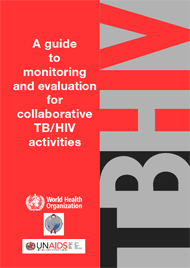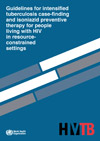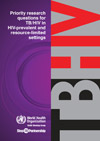Monitoring and evaluation: harmonization

A guide to monitoring and evaluation for collaborative TB/HIV activities assists in the management of TB and HIV control programmes to implement collaborative TB/HIV activities. It is intended to facilitate the collection of standardized data and help in the interpretation and dissemination of these data for programme improvement. It also aims to ensure consistency across all agencies and stakeholders involved in HIV, TB and collaborative TB/HIV activities, avoiding duplication of effort in data collection by providing a core set of internationally accepted and standardized indicators for monitoring and evaluating programme performance.
The revision of the TB/HIV indicators with institutional collaboration among WHO, UNAIDS, the Global Fund and PEPFAR has resulted in harmonized TB/HIV indicators. The harmonized indicators were communicated with TB and HIV implementers and national authorities using different channels of communication and included in the revised TB/HIV monitoring and evaluation guidelines. The main changes are that the number of TB/HIV indicators in this revision have been reduced from 20 to 12, and new indicators concerning the monitoring of TB in health-care workers and measuring case-finding, i.e. the detection of HIV-positive TB patients, as a percentage of country-estimated cases have been added.
Revised TB recording and reporting forms and registers - 2006 version
Three interlinked patient monitoring systems for HIV care/ART, MCH/PMTCT and TB/HIV
Integrated monitoring of tuberculosis and HIV: a case study from Malawi
Indicator summary
| Summary of indicators measured in HIV care settings by the HIV control programme | |
|---|---|
| Indicator B.1.1 | Number of adults and children enrolled in HIV care whose TB status was assessed and recorded during their last visit during the reporting period, expressed as a proportion of all adults and children enrolled in HIV care and seen for care in the reporting period. |
| Indicator B.1.2.1 | Number of adults and children enrolled in HIV care who startedTB treatment, expressed as a proportion of adults and children enrolled in HIV care during the reporting period. |
| Indicator B.1.2.2 | Percentage of estimated HIV positive incident TB cases that received treatment for TB and HIV. |
| Indicator B.2.1 | Number of adults and children newly enrolled in HIV care, who are started on treatment for latent TB infection, isoniazid preventive therapy, expressed as a proportion of the total number of adults and children newly enrolled in HIV care during the reporting period. |
| Indicator B.3.1 | Number of health-care facilities providing services for people living with HIV, with demonstrable infection control practices that include TB control, expressed as a proportion of the total number of health-care facilities evaluated. |
| Indicator B.3.2 | Number of health-care workers employed in facilities providing care for people living with HIV who develop TB in one year, expressed as a proportion of the total number of health-care workers employed in facilities providing care for people living with HIV during that same year. |
| Summary of indicators measured in TB care settings by the TB control programme | |
| Indicator C.1.1 | Percentage of TB patients who had an HIV test result a recorded in the TB register. |
| Indicator C.1.2.1 | Number of registered TB patients with documented HIV status on TB register who are HIV-positive, expressed as a proportion of the total number of all registered TB patients with documented HIV status over the reporting period. |
| Indicator C.1.2.2 | Number of TB patients registered with documented HIV status on TB register who are HIV-positive, expressed as a proportion of HIVpositive TB patients estimated to occur countrywide each year. |
| Indicator C.2.1 | Number of TB facilities where free condom distribution is practised and condoms are available, expressed as a proportion of all TB facilities. |
| Indicator C.3.1 | Number of HIV-positive TB patients who are started on or continue previously initiated CPT, during TB treatment, expressed as a proportion of all HIV-positive TB patients registered over the reporting period. |
| Indicator C.4.1 | Number of HIV-positive TB patients enrolled in HIV care services during TB treatment, expressed as a proportion of the total number of HIV-positive TB patients. |
| Indicator C.5.1 | Number of HIV-positive TB patients who are started on or continue previously initiated ART, during TB treatment, expressed as a proportion of all HIV-positive TB patients registered over the reporting period. |




 Intensive case finding and isoniazid preventive therapy guidelines, 2010
Intensive case finding and isoniazid preventive therapy guidelines, 2010
 Priority research questions for TB/HIV in HIV-prevalent and resource-limited settings, 2010
Priority research questions for TB/HIV in HIV-prevalent and resource-limited settings, 2010